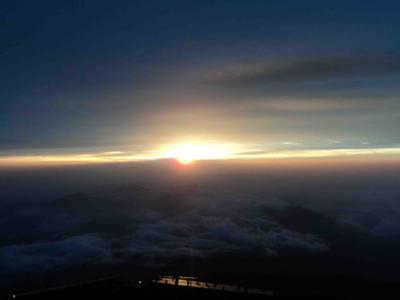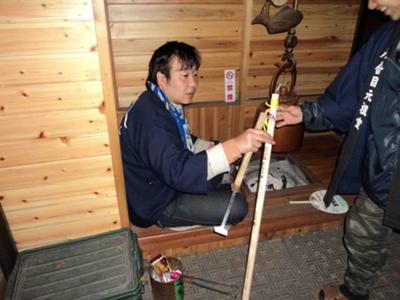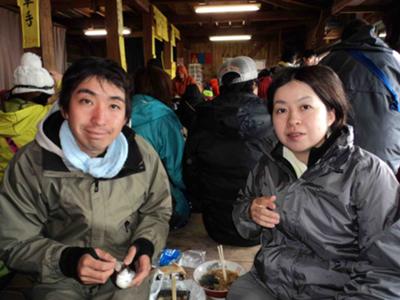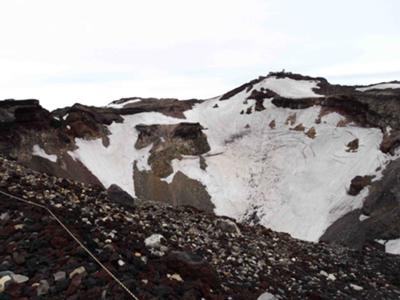Report From Mt. Fuji, July 2010
by Richard
(North Carolina, USA)

Mt. Fuji Sunrise at the Summit

Mt. Fuji Walking Sticks are Burned with Stamps
Representing the Station

Masaya and Naomi Enjoying Soba at the Mt. Fuji Summit

Mt. Fuji’s Volcanic Crater
My climb took place overnight, beginning around 10 pm on July 10 and returning the next day at about 1 pm, a journey up and back of about 15 hours. Joining me were two Japanese friends - Masaya and his girlfriend Naomi. Masaya, who had climbed the mountain once before, provided valuable guidance along the way, and his and Naomi's companionship enriched the experience.
The trip up the mountain took longer than expected, mainly because I began to develop symptoms of altitude sickness and needed to make several acclimation rest stops along the way. Even so, we reached the summit around the time of sunrise. Many climbers arrive at the summit by 4:30 am or earlier, waiting patiently in the cold wind to catch the first glimmers of sunlight. The climbing season for all but the most experienced climbers is June through July, when the weather conditions are tolerable and the trails clear of snow.
Most climbers begin at the Fifth Station, which is the highest elevation accessible by car. Among several routes to the top (each with its own Fifth Station), we took the Kawaguchiko-guchi trail, which is the most commonly used pathway and the best for seeing sunrise along the way. Some Mt. Fuji literature suggests that the ascent from the Kawaguchiko-guchi Fifth Station takes just 5 to 6 hours and the descent around 3 hours, but these time frames were unrealistic for us. Allowing for snack and toilet breaks, pauses to take in the spectacular views, occasional rest stops to acclimate to the altitude, and bottlenecks near the summit, our journey required 8 hours to the top and another 5 back down. This pace seemed to be about average, with some climbers moving faster while others took more time to reach the summit.
In planning for the climb, I did not fully anticipate the difficulty of the ascent. Because many Japanese climb Mt. Fuji, I assumed it would be easy, especially for someone like me who exercises regularly and is in good health. Wrong! The beginning of the trail, although on a fairly steep incline at times, was easy. But after the Eighth Station, we found ourselves on steep and rocky terrain where there was no identifiable trail. Instead, chains and ropes guided us upward while providing a lifeline to grab onto. Picking one's way through this surface of rocks and boulders was no easy task, especially given the degree of incline and the darkness. Although I carried a hand-held flashlight, a headlamp would have been much preferable in this area so that both hands were free to grab rocks and catch oneself during a stumble.
Later, the rocks and boulders gave way to smoother trail, but then the rough-and-tumble surface started up again as we neared the top. This latter part of the trail was the most arduous, requiring steady concentration to maintain good footing, especially after dark.
This is not a technical climb, and people of all ages and abilities handle it without too much difficulty. But in the middle of the night on an empty stomach with a strong wind blowing, the going gets tough at times, and you need to be prepared to stop now and then to catch your breath and to let faster climbers pass by. I had read that about half of Mt. Fuji climbers are foreigners, but for my overnight climb, most appeared to young Japanese men with an occasional young woman tagging along. I did see a couple of children who were seemingly unaffected by the altitude and lack of sleep, and several older couples were doing just fine. Regardless, there are a few serious accidents on the mountainside each climbing season, so it's best to be patient during the climb and not take any chances.
After spending some time on the summit, we traveled down the mountain at a steady pace, with only several rest stops. Still, the descent took a full 5 hours. The smooth and sandy return trail looked easy, but we quickly discovered how difficult it was to keep our footing while going downhill on the loose surface material. Traveling at a slow pace, we still slipped and fell to the ground several times, as did other climbers. I recall only two toilet stations on the return trail, so be prepared to use them wisely.
While planning for the journey to the summit, I discounted the possibility of altitude sickness, a common ailment for many Mt. Fuji climbers. Because I had previously climbed to even higher elevations in the U.S. without any adverse health consequences, I reasoned that Mt. Fuji would be no different. Wrong again! Altitude sickness symptoms include some combination of a throbbing headache, loss of appetite, nausea, and hyperventilation, all of which I had at one time or another - during the steepest climbing near the top, I could hardly take more than a few steps at times without stopping to catch my breath. Some other climbers seemed to be in the same condition, and I noticed that quite a few bought oxygen bottles at the Fifth Station to help make breathing easier. Next time I climb, I may consider taking preventative altitude sickness medication, and maybe I'll grab one of those Fifth Station oxygen bottles on the way up.
Of course, consult your doctor before taking any medication for altitude sickness. Also, you should immediately stop climbing if altitude sickness symptoms persist or if you are otherwise not feeling well. To avoid altitude sickness, some climbers rest at one of several mountain huts along the way, and others make a point of stopping for a time (a half-hour or longer) at each station. There are two first aid stations along the trail, and many climbers avoid the ill effects of climbing by turning around before reaching the summit. (The mountain huts take reservations and typically charge 5,000 to 7,000 yen for a stay of several hours; sometimes a warm meal is included.)
I was looking forward to using my new camera to capture the moment of our arrival at the summit and to photograph mountaintop scenes. But upon reaching the top, all I really wanted to do was to find the toilet and then the soba shop. I did take a few photos, but the weather was cold and windy, and frankly, there is not a lot to photograph up there. I took some shots of the volcanic crater, the soba shop, and the truly incredible views down the mountainside; I made sure to get "TOP MOUNT FUJI ALT 12,395" and "SUNRISE TOP MOUNT FUJI 2010" stamps burned into my walking stick to prove I was actually there (stamps are available in both English and Japanese); and then it was time to head back down to a warmer climate. Once at a lower elevation, my altitude sickness symptoms completely disappeared.
My clothing choices generally worked out well, thanks to some good advice found on several web sites. My clothing included:
- Low-cut, water resistant hiking shoes
- Wool hiking socks
- Several layers of breathable t-shirts (one long sleeve)
- Flannel shirt
- Heavy fleece outer layer
- Hooded rain jacket
- Hiking pants and pull-over rain pants
- Wool hat
- Warm gloves and light cotton gloves
Because of fluctuating wind chill temperatures and levels of exertion, I frequently added or removed layers to stay comfortable. (The Fifth Station temperature when we departed was a comfortable 24?C/75?F, while at the summit the next morning the temperature was below freezing with a blustery wind.) The light wool hat knitted by my Japanese mother-in-law was especially valuable as the temperature dropped overnight.
One clothing mistake I made was not to bring a pair of light cotton gloves for grabbing onto chains, ropes, and rocks. My heavy down-filled ski gloves were too bulky for this purpose, and consequently, I had to use my bare hands. This would have been a real problem had the weather been a little colder. (Light cotton gloves are for sale at the Fifth Station.) Additionally, as noted earlier, a headlamp would have been helpful in negotiating the higher elevations of the trail. Be sure to bring extra batteries.
I brought plastic sandwich bags to keep my cell phone, wallet, and camera dry; an eyeglass band to prevent my eyeglasses from blowing away when the winds picked up near the top; a baseball cap to keep the sunlight off my face during return trip; a large plastic bag to carry out my trash; and a small roll of toilet paper (although not needed). Some climbers also carry sunscreen and sunglasses. I managed to stuff all these supplies, some snack food, extra clothing, and water into a medium-size, waterproof backpack.
I also carried with me two liters of water (four bottles), which proved to add considerable weight to my backpack. Since drinks are available along the way, next time I will probably bring just a liter.
Fortunately, I took along plenty of 100 yen coins (100 yen is equivalent to about one U.S. dollar, depending on the exchange rate). The toilet facilities ask for a 200 yen donation (at one toilet it is required), and the walking stick stamps at each station are 200 yen each (300 yen for two stamps at the top). Three sizes of walking sticks are available at the Fifth Station for around 1,000 to 1,500 yen, and drinks and snacks along the trail require small change. A reasonably priced warm meal can be had at several coffee shops upon return to the Fifth Station.
Be sure to bring some food for the climb because there are long distances between several snack kiosks, none of which offer anything very appetizing - mainly canned drinks and instant noodles. (I did run across bananas at one location.) The soba for sale on top of the mountain was tasty and comforting after the long climb, and the soba shop provided a welcome refuge from the frigid morning air - prices ranged from around 800 to 2,500 yen.
And don't forget your camera!
Thank you for reading my Mt. Fuji report. If you have any questions, please write me at: mtfujiclimb@gmail.com, and see my web page for information on altitude sickness: http://climbingmtfuji.webs.com